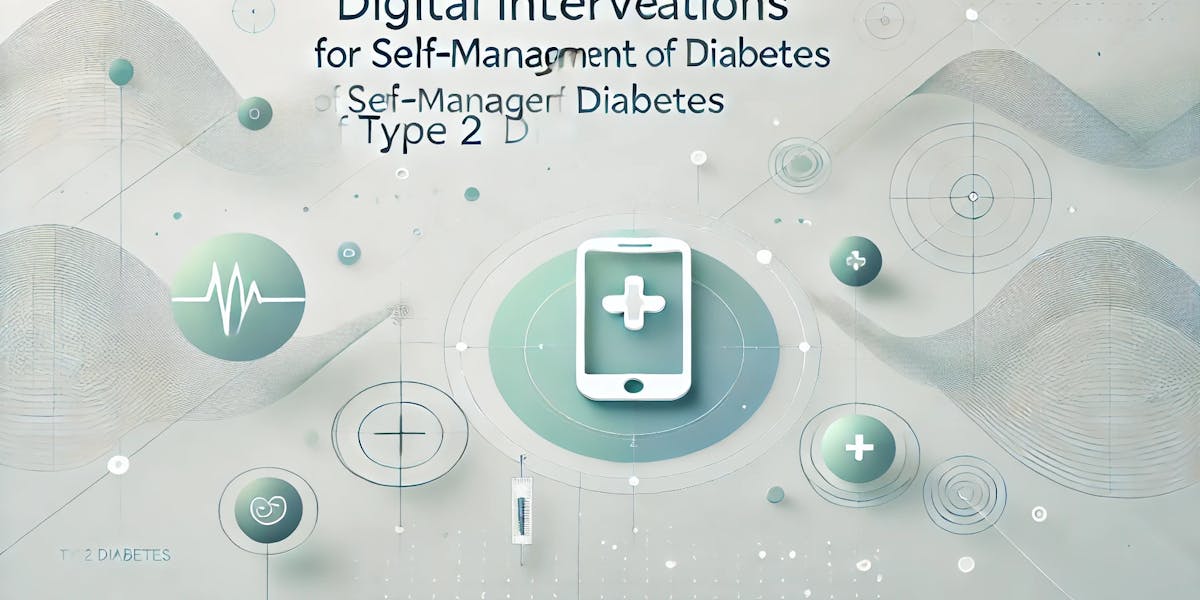Digital Interventions for Self-Management of Type 2 Diabetes
Journal of Medical Internet Research

Summary
This systematic review and meta-analysis examined 28 studies evaluating digital interventions for self-management of type 2 diabetes mellitus (T2DM), focusing primarily on HbA1c outcomes. The included studies were classified into three categories based on the intensity of coaching integrated with the digital technologies. Digital tools spanned mobile apps, glucose monitors, SMS, telemedicine platforms, and wearables. While most studies showed improvements in HbA1c, effectiveness appeared strongly influenced by the intensity and quality of the coaching provided. Coaching frequency, personalization, synchronous vs asynchronous communication, and coach qualifications were all examined as potential moderating factors. High- and medium-intensity coaching interventions showed statistically significant reductions in HbA1c when compared with usual care. Meta-analyses revealed a pooled HbA1c reduction of -0.31% across all studies using lab-confirmed outcomes. Notably, asynchronous coaching modes often outperformed synchronous ones, and higher communication frequency correlated with better outcomes. Participant engagement was high, and dropout rates were generally low. While most studies did not report significant adverse events, the reporting quality on harms was generally poor. The study concluded that digital interventions are effective and acceptable adjuncts to standard diabetes care, especially when paired with personalized coaching. However, scalability and cost remain challenges for widespread adoption.
Study Design
Interventions
Study Type
Outcomes
Duration and Size
Study Population
Age Range
Sex
Geography
Other Criteria
Methodology
This study used a systematic literature review following PRISMA and Cochrane methodologies, evaluating randomized controlled trials and comparative observational studies. Eligible studies involved adult T2DM patients using digital interventions with human coaching components. Study identification included Embase, MEDLINE, and CENTRAL, supplemented with conference proceedings and industry sources. Risk of bias was assessed independently by two reviewers using standard tools, with disagreements resolved by a third party. Data extraction and quality assessments were performed in parallel to minimize error.
Meta-analyses used a random-effects model to synthesize outcomes, primarily HbA1c changes. Subgroup and sensitivity analyses were performed based on coaching intensity, communication mode, and coach qualifications. Meta-regression was applied to explore interaction effects between intervention components and outcomes. Heterogeneity was assessed using I² and τ² statistics. Sensitivity analyses included exclusion of CGM-based or high-risk studies and incorporation of non-laboratory HbA1c values to evaluate robustness.
Interventions
Interventions included a mix of self-monitoring blood glucose systems, CGM, mobile apps, text messaging, wearable tech, and teleconferencing. Coaching intensity varied by intervention group. High-intensity interventions included real-time data uploads, frequent individualized coaching, and behavioral counseling with diabetes educators. Medium-intensity coaching provided ad hoc personalized feedback but lacked behavioral depth. Low-intensity interventions involved delayed and generic feedback with minimal education. All interventions sought to improve HbA1c through digital tools combined with human support.
Key Findings
Digital interventions for T2DM led to statistically significant reductions in HbA1c compared to usual care. The effect size was stronger for interventions with high-intensity coaching. While coaching medium (in-person vs asynchronous) was less influential, personalization and frequency of interaction had a notable effect. Meta-analysis showed a pooled reduction of –0.31% in HbA1c across all studies. Participants also reported higher satisfaction and engagement, and dropout rates were generally low. Overall, digital interventions were shown to be a feasible and effective adjunct to standard diabetes care.
Comparison with other Studies
The observed HbA1c reductions are consistent with other meta-analyses evaluating mobile health or telemedicine in T2DM. Previous research also supports the idea that human coaching enhances digital tool effectiveness. However, this study is among the few to stratify outcomes by coaching intensity and communication mode. Unlike older reviews that generalized intervention outcomes, this analysis adds granularity by categorizing synchronous vs asynchronous contact and the qualifications of coaches. It also confirms the modest but clinically meaningful HbA1c benefits of digital health in diabetes care.
While many reviews support digital interventions, most fail to account for the impact of intervention delivery design. By contrast, this study identifies intensity and personalization as key contributors to success. It reinforces previous findings from behavior change theory and digital health frameworks that underscore the importance of tailored feedback and engagement. The insights may inform future intervention design, policy, and scalability decisions for managing chronic diseases through technology.
Journal Reference
Kerr D, Ahn D, Waki K, Wang J, Breznen B, Klonoff DC. Digital Interventions for Self-Management of Type 2 Diabetes Mellitus: Systematic Literature Review and Meta-Analysis. J Med Internet Res. 2024;26:e55757. doi:10.2196/55757
© 2025 deDiabetes. Licensed under CC BY (Attribution)
Stay informed. Stay ahead.
Subscribe now for the latest breakthroughs, expert insights, and cutting-edge updates in diabetes care—delivered straight to your inbox.